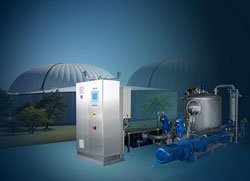Siemens' Crown system to help California water conservation plant improve efficiency and lower costs

Pre-fabricated and containerized for fast installation, the Siemens Industry Automation Division's Crown system is adaptable to variable loads and improves sludge dewaterability and digester stability.<br>
Siemens Industry Automation Division's Crown sludge disintegration system is expected to enhance anaerobic digester performance to increase biogas production by 15-20%. This will result in lower plant operating and power costs from beneficial reuse of biogas and reduced solids disposal. The system is expected to become operational in the spring of 2012.
The Crown system from Siemens Water Technologies, a business unit of Siemens Industry Automation Division, works by pre-conditioning biosolids prior to digestion through homogenization and hydrolysis of the bacterial cells. The process helps to improve the degradability of the biosolids in the digesters and also helps to minimize digester foaming caused by filamentous microorganisms. Estimated annual savings from added power production and reduced solids disposal will range from US$150,000 to US$250,000.
The system will be designed to treat all of the secondary sludge from Visalia's 18-MGD (68 MLD) treatment plant and can also be expanded to handle additional future loadings. The system will be skid-mounted and delivered to the site pre-piped and pre-wired, ready for connection to onsite utilities.
To learn more about the Crown sludge disintegration system, please stop by WEFTEC.11 Booth # 1549 or visit www.siemens.com/weftec.
The Siemens Industry Sector (Erlangen, Germany) is the world's leading supplier of innovative and environmentally friendly products and solutions for industrial customers. With end-to-end automation technology and industrial software, solid vertical-market expertise, and technology-based services, the Sector enhances its customers' productivity, efficiency, and flexibility. With a global workforce of more than 100,000 employees, the Industry Sector comprises the Divisions Industry Automation, Drive Technologies and Customer Services as well as the Business Unit Metals Technologies. For more information, visit http://www.siemens.com/industry
The Siemens Industry Automation Division (Nuremberg, Germany) supports the entire value chain of its industrial customers – from product design to production and services – with an unmatched combination of automation technology, industrial control technology, and industrial software. With its software solutions, the Division can shorten the time-to-market of new products by up to 50 percent. Industry Automation comprises five Business Units: Industrial Automation Systems, Control Components and Systems Engineering, Sensors and Communications, Siemens PLM Software, and Water Technologies. For more information, visit http://www.siemens.com/industryautomation
Reference Number: IIA2011102803e
Contact
Mr. Peter Jefimiec
Industry Automation Division
Siemens AG
Gleiwitzerstr. 555
90475 Nürnberg
Germany
Tel: +49 (911) 895-7975
peter.jefimiec@siemens.com
Contact USA
Mrs. Allison Britt
Water Technologies Business Unit
Siemens Industry, Inc.
2501 N. Barrington Rd
Hoffman Estates
IL 60192
USA
Tel: +1 (847) 713-8477
allison.britt@siemens.com
Media Contact
More Information:
http://www.siemens.com/weftecAll latest news from the category: Corporate News
Newest articles

Making diamonds at ambient pressure
Scientists develop novel liquid metal alloy system to synthesize diamond under moderate conditions. Did you know that 99% of synthetic diamonds are currently produced using high-pressure and high-temperature (HPHT) methods?[2]…

Eruption of mega-magnetic star lights up nearby galaxy
Thanks to ESA satellites, an international team including UNIGE researchers has detected a giant eruption coming from a magnetar, an extremely magnetic neutron star. While ESA’s satellite INTEGRAL was observing…

Solving the riddle of the sphingolipids in coronary artery disease
Weill Cornell Medicine investigators have uncovered a way to unleash in blood vessels the protective effects of a type of fat-related molecule known as a sphingolipid, suggesting a promising new…





















